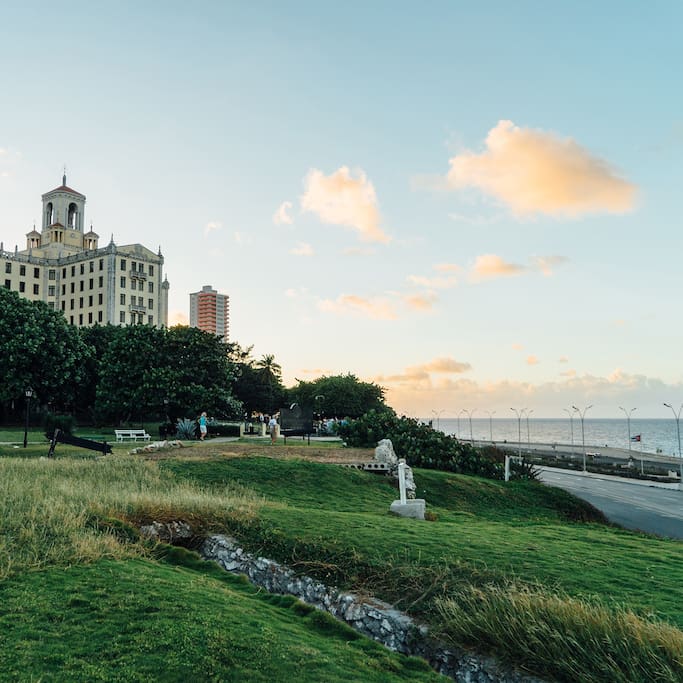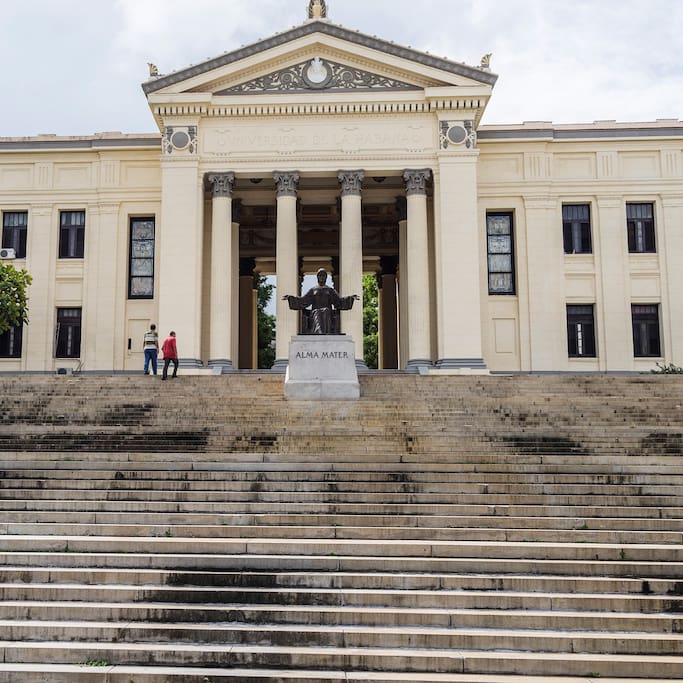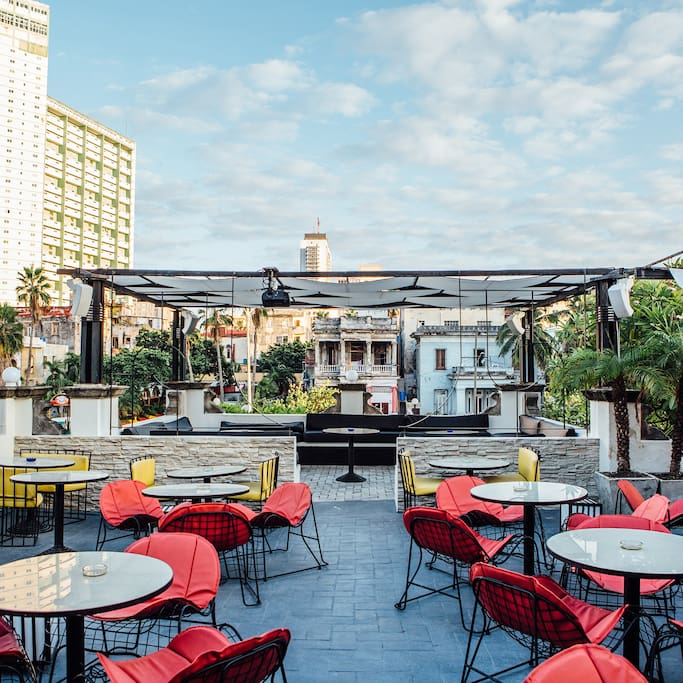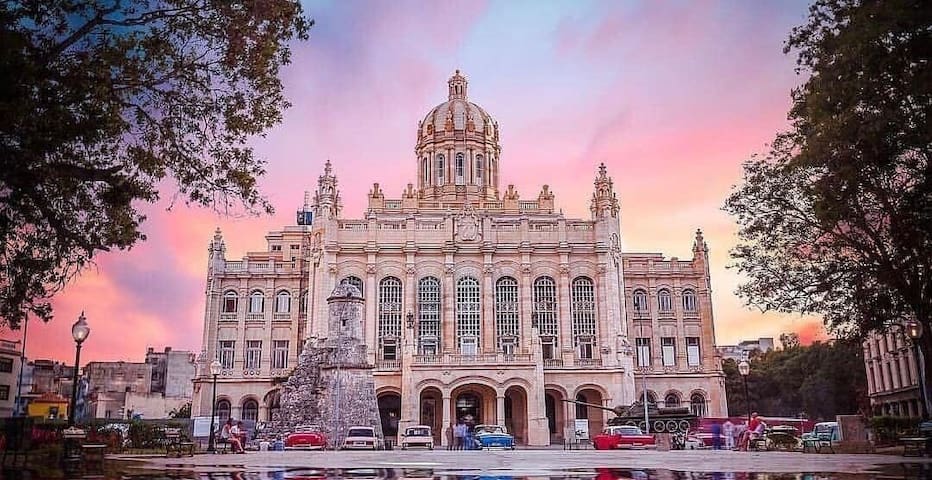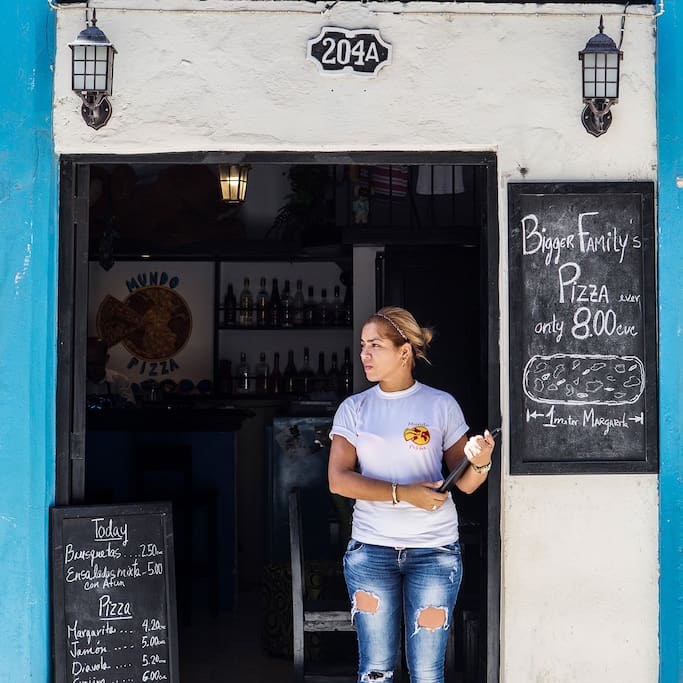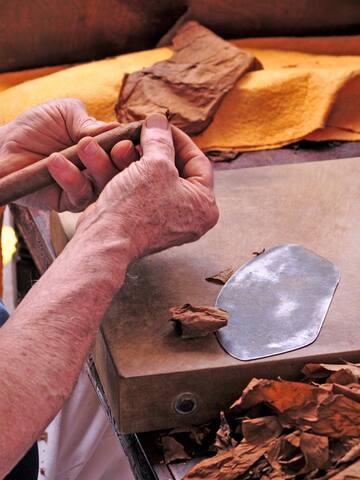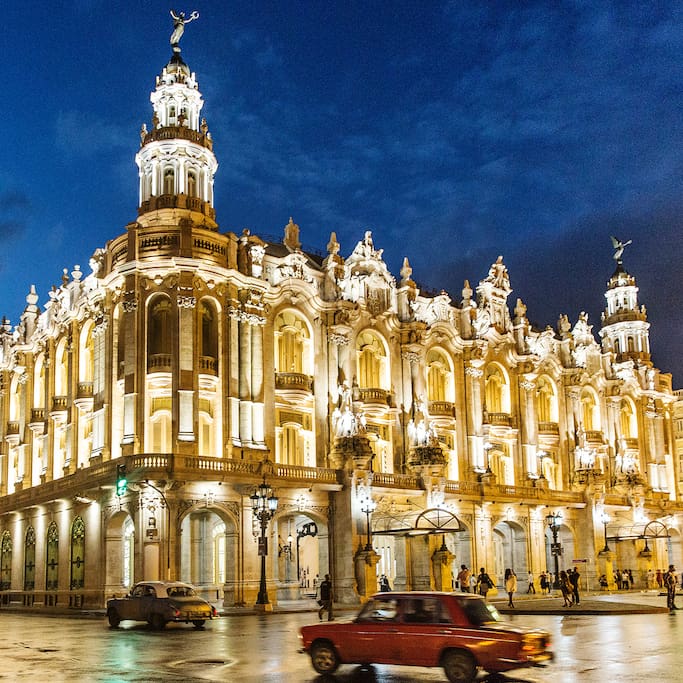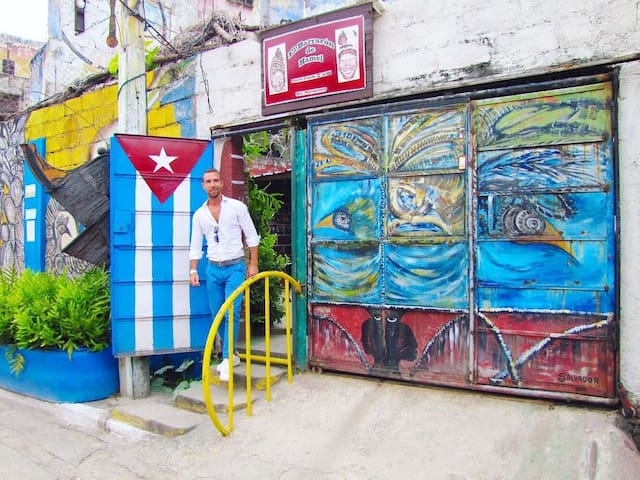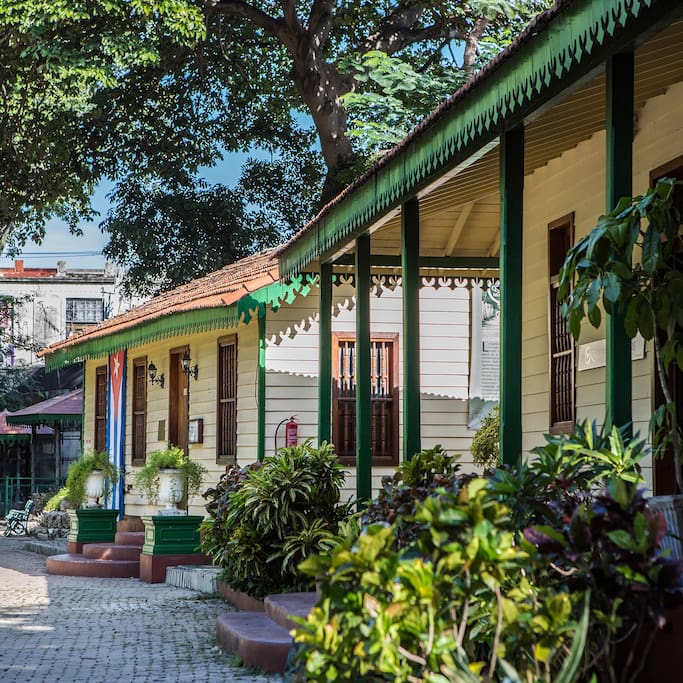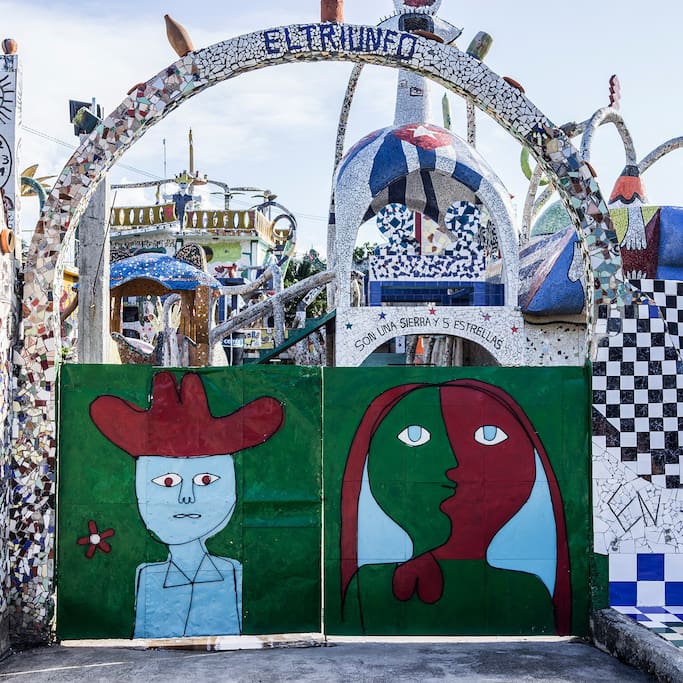Vedado
The neoclassical/neocolonial/art deco Hotel Nacional is as much a city monument as it is an international accommodation option. Superbly located overlooking the Malecón, with extensive gardens to take the sea air, the Nacional is classic, elegant and history personified. Many famous guests favor this stately, glamorous hotel – especially during the annual Film Festival, headquartered here.
You can discover it by taking a Convertible Car Ride Tour.
Calle 21 y O, Vedado, Plaza La Habana, 10400, Cuba
552 locals recommend
Hotel Nacional de Cuba
The neoclassical/neocolonial/art deco Hotel Nacional is as much a city monument as it is an international accommodation option. Superbly located overlooking the Malecón, with extensive gardens to take the sea air, the Nacional is classic, elegant and history personified. Many famous guests favor this stately, glamorous hotel – especially during the annual Film Festival, headquartered here.
You can discover it by taking a Convertible Car Ride Tour.
Calle 21 y O, Vedado, Plaza La Habana, 10400, Cuba
The Malecón (officially Avenida de Maceo) is a broad esplanade, roadway, and seawall that stretches for 8 km (5 miles) along the coast in Havana, Cuba,[1] from the mouth of Havana Harbor in Old Havana, along the north side of the Centro Habana neighborhood and the Vedado neighborhood, ending at the mouth of the Almendares River
244 locals recommend
Malecón
MalecónThe Malecón (officially Avenida de Maceo) is a broad esplanade, roadway, and seawall that stretches for 8 km (5 miles) along the coast in Havana, Cuba,[1] from the mouth of Havana Harbor in Old Havana, along the north side of the Centro Habana neighborhood and the Vedado neighborhood, ending at the mouth of the Almendares River
The Museo Nacional de Artes Decorativas (National Museum of Decorative Arts) is housed within a rather interesting building in the district of Vedado, Havana. The construction was designed by French architects Virad and Dastugue, surrounded by beautiful gardens with sculptures.
Among the items stored within the museums and the ones on display in its exhibition rooms, this museum has more than 33,000 works of high artistic and historic value from the reigns of Louis XV, Louis XVI and Napoleón II, as well as some oriental pieces dating from the 16th to the 21st centuries.
Calle 17 Esq. E, Vedado
196 locals recommend
Museo de Artes Decorativas
The Museo Nacional de Artes Decorativas (National Museum of Decorative Arts) is housed within a rather interesting building in the district of Vedado, Havana. The construction was designed by French architects Virad and Dastugue, surrounded by beautiful gardens with sculptures.
Among the items stored within the museums and the ones on display in its exhibition rooms, this museum has more than 33,000 works of high artistic and historic value from the reigns of Louis XV, Louis XVI and Napoleón II, as well as some oriental pieces dating from the 16th to the 21st centuries.
Calle 17 Esq. E, Vedado
The Museo Napoleónico (Napoleonic Museum) is located in a construction that was originally used as a home by Orestes Ferrara, one of the authors of the collection currently exhibited in the museum. It is a mansion inspired by a 16th century Renaissance Florentine palace and built in the 1920s by architects Govantes and Cabarrocas. The mansion, located in the district of Vedado (Municipio Plaza de la Revolución) of Havana, was built in Italian marble, wrought iron and finest quality woods
216 locals recommend
Napoleon Museum
The Museo Napoleónico (Napoleonic Museum) is located in a construction that was originally used as a home by Orestes Ferrara, one of the authors of the collection currently exhibited in the museum. It is a mansion inspired by a 16th century Renaissance Florentine palace and built in the 1920s by architects Govantes and Cabarrocas. The mansion, located in the district of Vedado (Municipio Plaza de la Revolución) of Havana, was built in Italian marble, wrought iron and finest quality woods
The Universidad de La Habana (University of Havana) was founded by Dominican monks from the Order of Preachers in 1728, and secularized in 1842. The university was originally located in Old Havana, but was moved in 1902 to Vedado to this Neoclassical construction from the second quarter of the 20th century.
This university is the oldest in Cuba and one of the first in America. Its building was declared a National Monument in 1978.
At the lower end of the stairway of the University of Havana is the Monument to Julio Antonio Mella, dedicated to the student leader who founded the first Cuban Communist Party in 1925 and was assassinated by the order of Machado in Mexico City. This is one of the most well-known parts of the University, as other than the monument, there are black and white portraits of Mella on display, hanging on walls in the park just in front of San Lázaro.
402 locals recommend
Universidad de la Habana
The Universidad de La Habana (University of Havana) was founded by Dominican monks from the Order of Preachers in 1728, and secularized in 1842. The university was originally located in Old Havana, but was moved in 1902 to Vedado to this Neoclassical construction from the second quarter of the 20th century.
This university is the oldest in Cuba and one of the first in America. Its building was declared a National Monument in 1978.
At the lower end of the stairway of the University of Havana is the Monument to Julio Antonio Mella, dedicated to the student leader who founded the first Cuban Communist Party in 1925 and was assassinated by the order of Machado in Mexico City. This is one of the most well-known parts of the University, as other than the monument, there are black and white portraits of Mella on display, hanging on walls in the park just in front of San Lázaro.
The José Martí Memorial is located in the center of Plaza de la Revolución Square of Havana. It is a huge monument almost 142 meters tall and 78,50 in diameter, and so the tallest structure in all of Havana.
The monument houses a museum and a viewpoint 129 meters high from which you’ll enjoy amazing views over the city after climbing a 567-step staircase
79 locals recommend
José Martí Memorial
Avenida PaseoThe José Martí Memorial is located in the center of Plaza de la Revolución Square of Havana. It is a huge monument almost 142 meters tall and 78,50 in diameter, and so the tallest structure in all of Havana.
The monument houses a museum and a viewpoint 129 meters high from which you’ll enjoy amazing views over the city after climbing a 567-step staircase
An urban jungle just under the bridge of Calle 23, the Parque Almendares, also known as Parque Metropolitana, is located in the heart of the lively Vedado area. This is a popular place for Cuban family outings, where kids and people of all ages hang out under the shade of trees on hot summer days. There is a small golf course, an outdoor performance area frequented by local bands and a dinosaur park.
224 locals recommend
Parque Almendares
An urban jungle just under the bridge of Calle 23, the Parque Almendares, also known as Parque Metropolitana, is located in the heart of the lively Vedado area. This is a popular place for Cuban family outings, where kids and people of all ages hang out under the shade of trees on hot summer days. There is a small golf course, an outdoor performance area frequented by local bands and a dinosaur park.
In 2000, a statue honoring the memory of Beatles cofounder John Lennon was installed amid great ceremony in Vedado, Havana, as Parque Menocal became Parque John Lennon. Calling Lennon a fellow revolutionary, then-President Fidel Castro unveiled the bronze model of the musician seated on a park bench. At the statue’s feet, an inscription reads in Spanish, “You may say I’m a dreamer, but I’m not the only one,” a translation from Lennon’s most famous solo song, “Imagine.”
217 locals recommend
Parque Lennon
Calle 8In 2000, a statue honoring the memory of Beatles cofounder John Lennon was installed amid great ceremony in Vedado, Havana, as Parque Menocal became Parque John Lennon. Calling Lennon a fellow revolutionary, then-President Fidel Castro unveiled the bronze model of the musician seated on a park bench. At the statue’s feet, an inscription reads in Spanish, “You may say I’m a dreamer, but I’m not the only one,” a translation from Lennon’s most famous solo song, “Imagine.”
Old Havana
In the Hotel Ambos Mundos, the room 511 stay exactly similar to when in her the North American celebrated writer Ernest Hemingway lived, his first residence in Cuba (1932-1939), space that was, as he said, ideal to write. At the present time it is conserved as museum, rather well-known as The room of Hemingway.
153 Obispo, La Habana, Cuba
83 locals recommend
Ambos Mundos Hotel
153 ObispoIn the Hotel Ambos Mundos, the room 511 stay exactly similar to when in her the North American celebrated writer Ernest Hemingway lived, his first residence in Cuba (1932-1939), space that was, as he said, ideal to write. At the present time it is conserved as museum, rather well-known as The room of Hemingway.
153 Obispo, La Habana, Cuba
A visit to the Havana Club Museum of Rum isn't merely a journey back to the origins of Cuba's most famous beverage. From freshly cut stalks of sugar cane to a reconstitution of a distillery and ageing cellars, the museum offers a real-time experience of the rum-making process, as well as a taste of true Cuban culture.
222 locals recommend
Museo del Ron Havana Club
A visit to the Havana Club Museum of Rum isn't merely a journey back to the origins of Cuba's most famous beverage. From freshly cut stalks of sugar cane to a reconstitution of a distillery and ageing cellars, the museum offers a real-time experience of the rum-making process, as well as a taste of true Cuban culture.
Even with no artifacts, the Museum of the Havana City would be a tour de force, courtesy of the opulent palace in which it resides. Filling the whole west side of Plaza de Armas, the Palacio de los Capitanes Generales dates from the 1770s and is a textbook example of Cuban baroque architecture, hewn out of rock from the nearby San Lázaro quarries. A museum has resided here since 1968.
116 locals recommend
Palacio De Los Capitanes Generales
Cuba TacónEven with no artifacts, the Museum of the Havana City would be a tour de force, courtesy of the opulent palace in which it resides. Filling the whole west side of Plaza de Armas, the Palacio de los Capitanes Generales dates from the 1770s and is a textbook example of Cuban baroque architecture, hewn out of rock from the nearby San Lázaro quarries. A museum has resided here since 1968.
Emblematic museum that resides in the former Presidential Palace, constructed between 1913 and 1920 and used by a string of Cuban presidents, culminating in Fulgencio Batista. The world-famous Tiffany's of New York decorated the interior, and the shimmering Salón de los Espejos (Hall of Mirrors) was designed to resemble the eponymous room at the Palace of Versailles.
780 locals recommend
Museum of the Revolution (Museo de la Revolucion)
Avenida BélgicaEmblematic museum that resides in the former Presidential Palace, constructed between 1913 and 1920 and used by a string of Cuban presidents, culminating in Fulgencio Batista. The world-famous Tiffany's of New York decorated the interior, and the shimmering Salón de los Espejos (Hall of Mirrors) was designed to resemble the eponymous room at the Palace of Versailles.
The incomparable Capitolio Nacional is Havana's most ambitious and grandiose building, constructed after the post-WWI boom ('Dance of the Millions') gifted the Cuban government a seemingly bottomless vault of sugar money. Similar to the Capitol in Washington, DC, but actually modeled on the Panthéon in Paris, the building was initiated by Cuba's US-backed dictator Gerardo Machado in 1926 and took 5000 workers three years, two months and 20 days to construct, at a cost of US$17 million.
461 locals recommend
Havana
66 CienfuegosThe incomparable Capitolio Nacional is Havana's most ambitious and grandiose building, constructed after the post-WWI boom ('Dance of the Millions') gifted the Cuban government a seemingly bottomless vault of sugar money. Similar to the Capitol in Washington, DC, but actually modeled on the Panthéon in Paris, the building was initiated by Cuba's US-backed dictator Gerardo Machado in 1926 and took 5000 workers three years, two months and 20 days to construct, at a cost of US$17 million.
La Bodeguita del Medio is one of the most famous restaurants in Havana and also in Cuba. It is a must-see when you visit Old Havana, where famous writers and artists and important politicians have passed through. The journalist Leandro Garcia, after signing the wall of this place, started the tradition that the celebrities who pass through it leave a mark or a memory, either in the form of a photo, an object, or graffiti. You can find historical signatures such as Salvador Allende, Ernest Hemingway, or Pablo Neruda, among many others.
743 locals recommend
La Bodeguita Del Medio
EmpedradoLa Bodeguita del Medio is one of the most famous restaurants in Havana and also in Cuba. It is a must-see when you visit Old Havana, where famous writers and artists and important politicians have passed through. The journalist Leandro Garcia, after signing the wall of this place, started the tradition that the celebrities who pass through it leave a mark or a memory, either in the form of a photo, an object, or graffiti. You can find historical signatures such as Salvador Allende, Ernest Hemingway, or Pablo Neruda, among many others.
The Castillo de la Real Fuerza Castle is a great sample of military architecture during the Spain's rule over the Caribbean. It is located in the Plaza de Armas Square in Old Havana facing the sea. The Castle, as well as the rest of the old city’s fortifications, has been declared World Heritage Site by UNESCO.
851 locals recommend
Museo Nacional de Bellas Artes
ObispoThe Castillo de la Real Fuerza Castle is a great sample of military architecture during the Spain's rule over the Caribbean. It is located in the Plaza de Armas Square in Old Havana facing the sea. The Castle, as well as the rest of the old city’s fortifications, has been declared World Heritage Site by UNESCO.
The Casa de Africa was founded in 1986 in a colonial palace in Old Havana to showcase the history and culture of Africa.
There are valuable collections from 27 African countries, based on the collection of researcher Fernando Ortiz, who first used the term Afro-Cuban, and also on the African collection of Fidel Castro, which consists principally of pieces sent by grateful recipients of Cuban aid..
The institution does research on the countries represented in its collections, especially those that had a direct influence on Cuba' culture.
13 locals recommend
Casa de África
The Casa de Africa was founded in 1986 in a colonial palace in Old Havana to showcase the history and culture of Africa.
There are valuable collections from 27 African countries, based on the collection of researcher Fernando Ortiz, who first used the term Afro-Cuban, and also on the African collection of Fidel Castro, which consists principally of pieces sent by grateful recipients of Cuban aid..
The institution does research on the countries represented in its collections, especially those that had a direct influence on Cuba' culture.
This museum hosts a 1:500 scale model of Old Havana, one of the most important of these models in all of Cuba, and is considered as a place of great interest, knowledge and entertainment by its inhabitants.
It is continuously updated and is rather impressive due to the incredible attention to detail in its works in regards to some of the most important buildings of Old Havana.
At the entrance to the museum lies a Cuban flag made of clay. It illuminates the adjacent room in shades of white, blue and red when crossed by sunlight, a work by the Italian artist Stellana Paletti. This is one of Old Havana’s must-visit museums, as it allows you to imagine what the historical center of Havana is like as a whole, and therefore being able to get a better look at it when walking its streets.
35 locals recommend
Maqueta de La Habana
This museum hosts a 1:500 scale model of Old Havana, one of the most important of these models in all of Cuba, and is considered as a place of great interest, knowledge and entertainment by its inhabitants.
It is continuously updated and is rather impressive due to the incredible attention to detail in its works in regards to some of the most important buildings of Old Havana.
At the entrance to the museum lies a Cuban flag made of clay. It illuminates the adjacent room in shades of white, blue and red when crossed by sunlight, a work by the Italian artist Stellana Paletti. This is one of Old Havana’s must-visit museums, as it allows you to imagine what the historical center of Havana is like as a whole, and therefore being able to get a better look at it when walking its streets.
The Fototeca de Cuba (Photographic Gallery of Cuba) is located next to the Plaza Vieja Square of Havana. The goals of this institution are to promote, exhibit and maintain international and Cuban photographic production.
The Fototeca de Cuba hosts an interesting gallery of Cuban and international photography. It is interesting to know that it also functions as the main photographic archive for the Old Havana Historian’s Office.
7 locals recommend
Fototeca de Cuba
307 MercaderesThe Fototeca de Cuba (Photographic Gallery of Cuba) is located next to the Plaza Vieja Square of Havana. The goals of this institution are to promote, exhibit and maintain international and Cuban photographic production.
The Fototeca de Cuba hosts an interesting gallery of Cuban and international photography. It is interesting to know that it also functions as the main photographic archive for the Old Havana Historian’s Office.
Regla
This wave-lashed fort with its emblematic lighthouse was erected between 1589 and 1630 to protect the entrance to Havana harbor from pirates and foreign invaders (French corsair Jacques de Sores had sacked the city in 1555). Perched high on a rocky bluff above the Atlantic, the fort has an irregular polygonal shape, 3m-thick walls and a deep protective moat, and is a classic example of Renaissance military architecture.
566 locals recommend
Castillo De Los Tres Reyes Del Morro
This wave-lashed fort with its emblematic lighthouse was erected between 1589 and 1630 to protect the entrance to Havana harbor from pirates and foreign invaders (French corsair Jacques de Sores had sacked the city in 1555). Perched high on a rocky bluff above the Atlantic, the fort has an irregular polygonal shape, 3m-thick walls and a deep protective moat, and is a classic example of Renaissance military architecture.
Christ of Havana Statue in Havana is located in the town of Casablanca, across the bay from Old Havana. The Christ is a statue of white marble created in 1958 in Italy by Cuban artist Jilma Madera.
166 locals recommend
Christ of Havana
Christ of Havana Statue in Havana is located in the town of Casablanca, across the bay from Old Havana. The Christ is a statue of white marble created in 1958 in Italy by Cuban artist Jilma Madera.
Fortaleza de San Carlos de la Cabaña Fortress is located in a hill in the eastern side of the port of Havana. This vast fortress was erected in the 18th century, between 1763 and 1774, as way of protecting the weakest spot of the city’s defense system.
Nowadays, the fortress is restored to welcome tourists and it can take as much as a whole day to visit it all! You will find plenty of bars, restaurants, souvenir stores, and the world’s largest tobacco store here too. The fortress also houses the Museo de Fortificaciones y Armas (Fortress and Weapons Museum) and the Museo de la Comandancia del Che (El Che’s Headquarters Museum). Everyday at 9pm, the cannon is fired in a ceremony where actors dressed in period costumes from the 18th century fire the cannon over Havana’s port, which was the signal, until the year 1850, of the closing of the city’s gates.
172 locals recommend
La Cabaña
Fortaleza de San Carlos de la Cabaña Fortress is located in a hill in the eastern side of the port of Havana. This vast fortress was erected in the 18th century, between 1763 and 1774, as way of protecting the weakest spot of the city’s defense system.
Nowadays, the fortress is restored to welcome tourists and it can take as much as a whole day to visit it all! You will find plenty of bars, restaurants, souvenir stores, and the world’s largest tobacco store here too. The fortress also houses the Museo de Fortificaciones y Armas (Fortress and Weapons Museum) and the Museo de la Comandancia del Che (El Che’s Headquarters Museum). Everyday at 9pm, the cannon is fired in a ceremony where actors dressed in period costumes from the 18th century fire the cannon over Havana’s port, which was the signal, until the year 1850, of the closing of the city’s gates.
Centro Habana
Cuban cigar is the Caribbean’s stellar cigar product that has been in production for many years. There is a booming premium cigar market, but the Cuban Cigar has a history that not many modern cigar companies can match. The best way to learn and understand the phenomenon is to partake in at least one of the several available Cuban cigar factory tours.
27 locals recommend
Fabrica de Tabaco Romeo Y Julieta
Padre VarelaCuban cigar is the Caribbean’s stellar cigar product that has been in production for many years. There is a booming premium cigar market, but the Cuban Cigar has a history that not many modern cigar companies can match. The best way to learn and understand the phenomenon is to partake in at least one of the several available Cuban cigar factory tours.
The Gran Teatro of Havana, center of Ballet and National Opera of Cuba, is located in Centro Habana, in Paseo Martí (Martí Promenade). Nowadays the building is part of a great cultural complex with several rooms, and is one of the most important cultural institutions in latin America.
682 locals recommend
Great Theatre of Havana
458 P.º de MartíThe Gran Teatro of Havana, center of Ballet and National Opera of Cuba, is located in Centro Habana, in Paseo Martí (Martí Promenade). Nowadays the building is part of a great cultural complex with several rooms, and is one of the most important cultural institutions in latin America.
CALLEJON DE HAMEL IS A narrow alley in Havana filled with lively colorful murals and sculptures made from bathtubs, hand pumps, and pinwheels. It offers visitors to Cuba’s capital a taste of the city’s local art.
390 locals recommend
Callejon de hamel
Callejon de HamelCALLEJON DE HAMEL IS A narrow alley in Havana filled with lively colorful murals and sculptures made from bathtubs, hand pumps, and pinwheels. It offers visitors to Cuba’s capital a taste of the city’s local art.
The Chinese Quarter of Havana is located next to the El Capitolio de Cuba. The quarter is made up of five small streets, being the most important one the Calle de Los Dragones Street.
The historian Julio Riverend states that here settled around 150,000 Chinese between 1847 and 1874; but nowadays there is almost no Chinese people in here. The quarter is preserved thanks to the elderly Chinese still living here.
225 locals recommend
Chinatown
The Chinese Quarter of Havana is located next to the El Capitolio de Cuba. The quarter is made up of five small streets, being the most important one the Calle de Los Dragones Street.
The historian Julio Riverend states that here settled around 150,000 Chinese between 1847 and 1874; but nowadays there is almost no Chinese people in here. The quarter is preserved thanks to the elderly Chinese still living here.
The former stately residence of Independence War general Máximo Gómez, the Quinta sits in lush surroundings that have been managed as botanical gardens since 1839. While the former Gómez residence is closed, some of the grounds – with 160 tree species, 40 bird species and the tiny, colorful polymita snails that are endemic to Cuba – can be explored. There's also a butterfly enclosure, the first of its type in the country.
86 locals recommend
Quinta de los Molinos
The former stately residence of Independence War general Máximo Gómez, the Quinta sits in lush surroundings that have been managed as botanical gardens since 1839. While the former Gómez residence is closed, some of the grounds – with 160 tree species, 40 bird species and the tiny, colorful polymita snails that are endemic to Cuba – can be explored. There's also a butterfly enclosure, the first of its type in the country.
Playa
José Fuster has turned his home neighborhood into a masterpiece of intricate tilework and kaleidoscopic colors – a street-art extravaganza. The centerpiece is Fuster’s own house, Taller-Estudio José Fuster, a sizable residence decorated from roof to foundations by art, sculpture and – above all – mosaic tiles of every color and description.
116 locals recommend
Fusterlandia
José Fuster has turned his home neighborhood into a masterpiece of intricate tilework and kaleidoscopic colors – a street-art extravaganza. The centerpiece is Fuster’s own house, Taller-Estudio José Fuster, a sizable residence decorated from roof to foundations by art, sculpture and – above all – mosaic tiles of every color and description.

